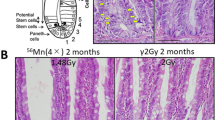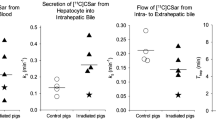Abstract
A NUMBER of authors have found disturbances in various liver functions, damage to the liver in the form of fatty degeneration, and increase in the total liver fats in various mammals after total body irradiation with lethal doses of X-rays. According to Ellinger1 these changes occur after irradiation with doses exceeding LD80, and the mechanism of their origin is not yet quite clear. Severe anæmia after irradiation, and resulting hypoxia of the liver and of other organs, might also occur. We have investigated this possibility, and have found that after total body irradiation with high doses a striking relation exists between the decrease in red blood cell count and the amount of total liver fats.
This is a preview of subscription content, access via your institution
Access options
Subscribe to this journal
Receive 51 print issues and online access
$199.00 per year
only $3.90 per issue
Buy this article
- Purchase on Springer Link
- Instant access to full article PDF
Prices may be subject to local taxes which are calculated during checkout
Similar content being viewed by others
References
Ellinger, F., Radiology, 44, 241 (1945).
Kibrick, A. C., and Skupp, S. J., Arch. Biochem. Biophys., 44, 134 (1953).
Dowdy, A. H., Bennett, L. R., and Chastain, S. M., Radiology, 55, 879 (1950).
Bytchkovskaja, I. B., Strelin, G. S., and Shiffer, I. V., Med. Rad. (Moscow), 1, No. 3, 85 (1956).
Author information
Authors and Affiliations
Rights and permissions
About this article
Cite this article
SKALKA, M. Anæmia and Liver Damage in X-Irradiated Animals. Nature 182, 1602–1603 (1958). https://doi.org/10.1038/1821602b0
Issue Date:
DOI: https://doi.org/10.1038/1821602b0
This article is cited by
-
Influence of Blood Transfusions on Irradiated Rats
Nature (1962)
Comments
By submitting a comment you agree to abide by our Terms and Community Guidelines. If you find something abusive or that does not comply with our terms or guidelines please flag it as inappropriate.



